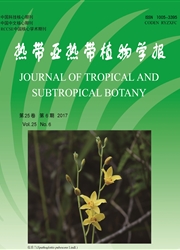

 中文摘要:
中文摘要:
为了解檀香吸器维管组织的发育过程,采用激光共聚焦显微镜、光学显微镜和透射电镜观察檀香吸器维管组织的个体发育。结果表明,檀香维管组织的分化分为两个时期:入侵前和入侵后。吸器维管组织发育始于盘状吸器时期,起源于吸器基部具有分生能力的细胞,后分为两束。侵入前无向顶的分化,处于吸器基部。侵入后随吸管深入寄主根与寄主根维管束连通,形成具有吸收功能的维管组织。成熟吸器维管组织呈倒烧瓶结构,仅处于吸器烧瓶核心两边,由木质部组成而无韧皮部。檀香的吸器维管组织发育有两个因素诱导,一个是遗传因素,另一个为寄主。这些为檀香半寄生性特性研究提供了形态解剖学基础。
 英文摘要:
英文摘要:
In order to understand the development of vascular tissue in Santalum album haustoria, the ontogenesis of vascular tissue in haustoria was observed under laser scanning confocal microscope, light microscopy and transmission electron microscopy. The results showed that the differentiation of haustorium vascular tissue in S.album could be divided into two stages: before and after invasion. The differentiation of vascular tissues ofhaustorium begin at disk-shaped stage, originating from meristematic cells at thebase of haustorium, and then,they divided into two bunches. Before invasion, the vascular tissues of haustorium are located at the base ofhaustorium without apical differentiation. After invasion, the vascular tissue started to differentiate and connectinto the host roots with absorption function. The vascular bundles of mature haustorium was inverted flask-shaped,and exist on two sides of kernel region. The vascular tissues contained only xylem without phloem. It wasproposed that the development of haustorium vascular tissue of S. album was induced by two factors, genetic factor and host root factor. Therefore, these would provide a anatomic basis for studying on semiparasite in Santalum album.
 同期刊论文项目
同期刊论文项目
 同项目期刊论文
同项目期刊论文
 Endogenous hormone levels and anatomical characters of haustoria in Santalum album L. seedlings befo
Endogenous hormone levels and anatomical characters of haustoria in Santalum album L. seedlings befo 期刊信息
期刊信息
